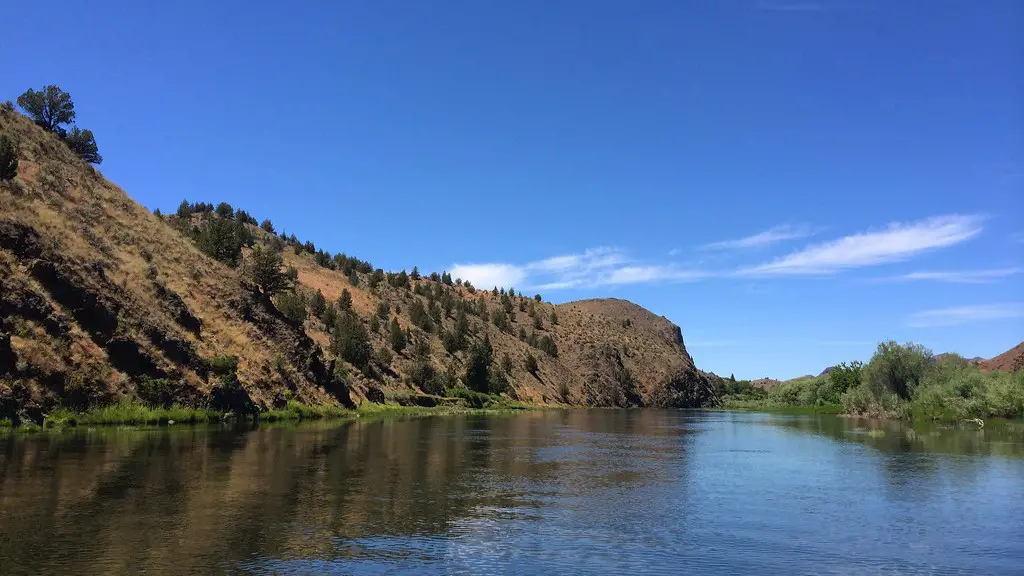The Nile River has been an integral part of Ancient Egyptian life for thousands of years. Its yearly flooding provided the silt and moisture which was necessary for the Egyptians to cultivate their crops. Without the Nile, the once lush and vibrant nation of Egypt would be reduced to just another desert on the face of the planet. By understanding what the Nile River provided, we can gain insight into how it shaped the lives of ancient Egyptians.
As the longest river in the world, the Nile River stretched over some 6,650 kilometers long and was the source of water for both drinking and irrigation. Without this vital source of water, it is estimated that up to 65% of the population of Ancient Egypt would have been unable to survive. The Nile provided a continuous source of water for the Egyptians, allowing them to build their cities, cultivate crops, and irrigate their fields. This made Egypt one of the very few places in the world which were able to support large populations.
The annual flooding of the Nile River also provided the Egyptians with a current to help them transport goods, both locally and to other regions. This allowed the Egyptians to acquire materials, such as wood and stone, which were necessary for building their cities and monuments. Furthermore, the Nile served as a navigable highway that gave the Egyptians access to both the Mediterranean Sea and the Red Sea.
In addition to providing an essential source of water and transportation, the Nile River also provided the Egyptians with a sense of stability. By understanding when the annual flooding would occur and how it would affect their land, the Egyptians were able to predict and plan agricultural practices with relative accuracy. This allowed the Egyptians to grow food more efficiently and develop more complex social systems. It also enabled them to build stable civilizations that could exist for centuries and pass on their knowledge from generation to generation.
The Nile River provided the foundation for Ancient Egyptian culture. It is no exaggeration to say that the success of Ancient Egypt was built upon the river. Without it, the Egyptians could not have developed an advanced civilization capable of lasting for thousands of years. So, it is clear to see why the Nile River played such an important role in the lives of ancient Egyptians and why it is still revered to this day.
Economic Impact on Ancient Egypt
Though the impact of the Nile River was multi-faceted, its greatest economic importance was in its ability to yield reliable harvests that were essential for the existence of Ancient Egypt. Without the Nile’s ability to flood the land, Egyptians would have had to rely heavily on the unpredictable rains distributed throughout the year. This made it impossible for them to cultivate an abundance of crops with any confidence. Thanks to the Nile, Pharaohs’ granted land for cultivation to priests, nobles, and farmers, and these generous gifts of land were used to produce food and other goods.
The flooding also provided the soil with much needed nutrients that allowed crops to flourish. Without this nutrient-rich topsoil, the agricultural production of the time is unlikely to have been able to be sustained. It is believed that the annual flooding of the river also provided the Egyptians with access to areas of fresh fish and other sea life, thus providing them with vital sources of protein for their diet.
Ancient Egyptians also enlisted a variety of specialist fishing boats to catch fish and other sea creatures along the river. This provided the source of food and also enabled them to trade. Egyptians traded fish, tools and cloth made from papyrus. Food and tools were supplied to nearby cities while papyrus and linen were exported to other kingdoms.
Social Impact on Ancient Egypt
The abundance of harvests that the Nile River provided allowed the Egyptians to live in relative security, where the availability of food was no longer a major concern. This allowed them to focus on more complex social relationships. Ancient Egyptian cities relied heavily on the Nile for their water supply, and so many important public buildings and monuments, such as the pyramids, were built near the river to take advantage of its wealth. With the availability of reliable water supplies, craftsmanship, commerce, and trade could flourish, thus providing more employment opportunities throughout the region.
The abundance of food provided to the people of Egypt also enabled them to lead longer, healthier lives. This allowed Egyptians to learn from their elders, pass on their knowledge and beliefs, and build a vibrant and diverse culture that is revered to this day. Without the Nile, the Ancient Egyptian people would have not been able to thrive as they did. Ancient Egypt laid the foundations for modern society, and it is clear to see why the Nile was so important to them.
Political Impact on Ancient Egypt
The Nile provided political stability to the people of Egypt and enabled them to build long lasting civilizations. The annual flooding of the Nile remained a source of political stability in the Ancient Egyptian world. Recognizing how critical the Nile was to the survival of their society, the ancient Egypt hierarchy strived to control the flow of the Nile and ensure that the annual floods occurred as expected. Furthermore, with an abundance of food, the Ancient Egyptian state was able to provide for its population, leading to greater loyalty throughout the region.
As the Cult of the Nile grew and the god Hapi was celebrated as the provider of life, the importance of the river and the Pharaohs who ruled over it was assured. The cult of the Nile gave the Pharaohs immense power, thus turning the river into a powerful political symbol. As a result, the Pharaohs were not only recognized as the providers of fertility of the land, but also the symbol of stability and the unifying force that kept the kingdom of Ancient Egypt together.
Artistic Impact on Ancient Egypt
The importance of the Nile for the people of Ancient Egypt was reflected in their art. Every aspect of Ancient Egyptian life was inextricably tied to the Nile. As such, the Nile has been represented in some form or another in many of their artworks. From temple reliefs to wall murals, depictions of the Nile were numerous. Furthermore, the river was represented in paintings, hymns, and sculptures, thus providing the people of Ancient Egypt with a visual reminder of their dependence and reverence of the Nile.
As a result of this, the Ancient Egyptians developed a sense of pride in their ability to live and work in harmony with the natural cycles of the river. This is evident in the way they were willing to patiently wait for the inundation and how they were able to adapt to its changing conditions. It is also reflected in the numerous sculptures and reliefs depicting the cycles of birth, death and rebirth associated with the river.
Regional Impact on Ancient Egypt
As a result of the fertility and stability brought about by the Nile, Ancient Egypt was able to become a regional power by controlling trade in the region and by providing resources to neighboring countries. As the river enabled farmers to produce abundant crops, it allowed them to serve as suppliers of food for other parts of the region, thus boosting the economy of Ancient Egypt. This allowed them to expand their influence and build strong relationships with their neighbors, thus furthering their political influence.
The Nile’s importance was further highlighted by its use as a source of transportation. The navigable highway provided by the river allowed traveling merchants to access goods from the other side of the continent. This facilitated the spread of trade goods, technology, and ideas, thus providing Ancient Egyptians with access to resources and knowledge from around the region.
Scientific Impact on Ancient Egypt
The importance of the Nile River to the scientific advancement of Ancient Egyptian can not be overstated. Having an abundance of water and the ability to predict the annual flooding of the river enabled the Egyptians to study the natural world and to build the foundations of mathematics and medicine. The abundance of resources provided by the Nile allowed the Ancient Egyptians to pursue scientific advancements such as astronomy, mathematics, engineering and medicine.
The Ancient Egyptians also developed sophisticated engineering projects such as irrigation systems, canals and reservoirs that were essential to managing the annual flooding of the Nile. This enabled them to better utilize the available water resources, allowing them to maximize their food production and learn how to predict the flooding of the Nile each year. Though their understanding of the environment was rudimentary by modern standards, it was still advanced enough to enable them to make use of the resources they were afforded.
The Ancient Egyptians also engaged in the study of botany and zoology, using the abundance of life in the Nile basin as a source of study. This allowed them to grow their understanding of the natural world and to develop treatments for some of the most common illnesses.




